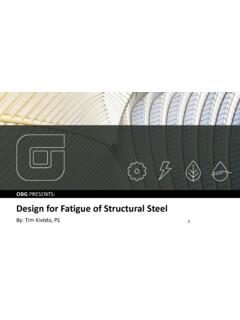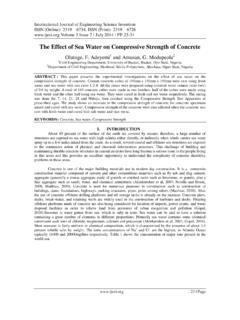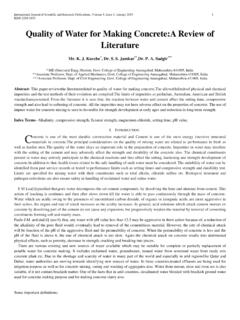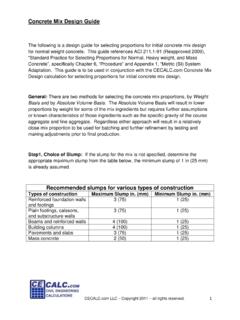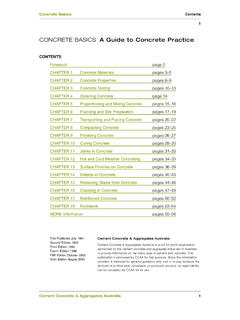Transcription of Cold Weather Concreting & Review of ACI 306
1 Bill Lyons FACI National Business Development Group Northeast Region201-401-3391 Weather Concreting & Review of ACI 306 November 12, 2018 Objectives/ Intent of Cold Weather set of rapid temperature damage from freezing at early protection consistent with serviceability of structureDiscussion Goals 6. Freeze Resistant Concrete7. Cold Weather concrete PlanGoal of ACI 306 Concreteplaced during cold Weather will develop sufficient strength and durability to satisfy the intended service requirements when it is properly produced, placed, and protected. The Key to Proper Cold Weather concrete is Managing RiskRisks of Cold protection against early freezing can cause immediate destruction or permanently weakened durability of concrete can be significantly reducedEffect of Between the hydration of cement (Generates heat as well as strength ) and heat a point after hydration, the concrete is strong enough to resist little hydration takes place below 40 FBladed ice crystals cast in cement paste- concrete froze while still set times in bottom of shrinkage Problems for Freshly-Mixed concrete in Cold WeatherTemperatures Approximate Setting Time 100 F (38 C) 2 hours 90 F (32 C )
2 3 hours 80 F (27 C ) 4 hours 70 F (21 C) 6 hours 60 F (16 C) 8 hours 50 F (10 C) 11 hours 40 F ( 4 C ) 14 hours Setting Time of concrete atVarious Temperatures (Delay)ASTM C-1622 / C-1622M-05 Standard Specification for Cold Weather Admixture Systems Determine the placement temperature of concrete according to ASTM C 1064/C1064M The more massive the concrete section, the less rapidly it loses heat. set times in bottom of shrinkage Problems for Freshly-Mixed concrete in Cold WeatherFrozen subgradeSubgrade Has Previously Been Thawed With Hoses, Blankets & set times in bottom of early finishing shrinkage Problems for Freshly-Mixed concrete in Cold WeatherIce/snow in set times in bottom of early finishing shrinkage cracking / CrazingPotential Problems for Freshly-Mixed concrete in Cold WeatherOver/ early of drying conditions, concrete may appear to be ready to finish or.
3 Require additional finishing air in the top potential for scalingOver/ early set times in bottom of early finishing shrinkage cracking / CrazingPotential Problems for Freshly-Mixed concrete in Cold WeatherPlastic Shrinkage relative subgrade or set of early protection from dryingWHEN WATER EVAPORATES OFF THE SURFACE TOO RAPIDLY, CRACKING USUALLY OCCURS. Plastic shrinkage occurs when the rate of evaporation of surface moisture exceeds the rate at which the rising bleed water can replace set times in bottom of early finishing shrinkage cracking / CrazingPotential Problems for Freshly-Mixed concrete in Cold WeatherHow to avoid plastic (or any other kind of) shrinkage the set (different from high-early concrete ) temporary evaporation evaporation retarder poly/plastic joint as soon as feasible-DO NOT WAIT!
4 ! a high quality curing compound, sooner rather than curing/insulating & Cure!!Curing!Issues that often arise in Cold t skimp / forget curing Cylinders Principles of Cold Weather ConcretingPrinciples of Cold Weather protected from freezing until it attains a compressive strength of at least 500 psi ( ) will not be damaged by exposure to a single freezing cycle (Powers 1962). a specified concrete strength should be attained in a few days or weeks, planning and protection may be required to maintain the concrete temperaturePrinciples of Cold Weather ConcretingUnder certain conditions, CaCl2should not be used to accelerate setting and hardening because of increased chances of corrosion of metals embedded in concrete or other adverse effectsRequired for DurabilityConcrete exposed to freeze/thaw while saturated requires lower w/cm than required for.
5 50 (4,000 psi) moderate to severe freeze/ .45 (4,500psi) deicing .40 (5,000 psi reinforced concrete subject to brackish water, sea water or deicing chemicals Guide to Cold Weather Concreting ACI 306R-16 * The word required is now changed to recommended. DEFINITION306R-88 Cold Weather ConcretingACI 306R-10 Definition: Cold Weather exists when the air temperature has fallen to, or is expected to fall below 40 Fduring the protection period. The protection period is defined as the time required to prevent concrete from being affected by exposure to cold Weather . Guide to Cold Weather Concreting ACI 306R-16 Balancing Risk in Producing concrete in Cold WeatherChapter 3: Objectives, Principles and Economy Added The temperature of concrete is measured in accordance with ASTM C1064.)
6 Rewritten- Maintain curing conditions that promote strength development without exceeding the recommended concrete temperatures in Table by more than 20 F and without using water curing, which may cause critical saturation at the end of the protection period, thus reducing resistance to freezing and thawing when protection is removed (Section ). Economy Cold Weather Concreting results in extra costs because of potentially lower worker productivity and additional needed products such as insulating blanket, tarping and heaters. But it may also allow a project to stay on schedule. Chapter 4: General Recommendations concrete Temperatures Deleted concrete placed at lower temperatures (40-55F), protected against freezing, and properly cured for a sufficient length of time, has the potential to develop higher ultimate strength and greater durability than concrete placed at higher temperatures.
7 (Klieger 1958)Chapter 4: Finishing Air-Entrained SlabsSlab hard troweled finish is specified, the addition of air entrainment may lead this case magnesium trowels should be used instead of steel tools. water-cementitious materials ratio (w/cm) should not exceed the limits recommended in ACI , and the concrete should be protected from freezing and thawing for the duration of the protection period. For steel-troweled floor and slab construction, air-entrained concrete should not be specified, and the concrete should be protected from freezing and thawing for the duration of the protection 4 Slab Rewritten Last sidewalks and other flatwork exposed to melting snow and cold Weather should be air-entrained and protected from freezing and thawing for the duration of the protection period.
8 Removed ..Until attaining at least 3500 Temperature RequirementsSection sizeminimum dimension, in. (mm)< 12 in.(300 mm)12-36 in.(300-900 mm)36-72 in.(900-1800 mm)> 72 in.(1800 mm)Air temperatureMinimum concrete temperature as placed and maintained 55 F (13 C)50 F (10 C)45 F (7 C)40 F (5 C)Minimum concrete temperature as mixed for indicated air temperature*Above 30 F(-1 C)60 F(16 C)55 F(13 C)50 F(10 C)45 F(7 C)0 to 30 F(-18 to 1 C)65 F(18 C)60 F(16 C)55 F(13 C)50 F(10 C)Below 0 F(-18 C)70 F (21 C)65 F (18 C)60 F (16 C)55 F (13 C) Maximum allowable gradualtemperature drop in first 24 hrsafter end of protection50 F (28 C)40 F (22 C)30 F (17 C)20 F (11 C)
9 Chapter 6 Preparation Before Concreting Massive Metallic Embedments Most embedmentsincluding bars, do not need to be heated unless the air temperature is below 10 F (-12C). Embedmentswith a cross-sectional area greater than 4 in2 should be heated to above 32deg F. Reinforcing bars smaller than No. 18 in size are not considered massive embedments. Chapter 6 Subgrade Condition In accordance with ACI 302, slabs should not be placed on frozen base or 2ndparagraph Limit surface temperatures of supporting materials beneath slabs on ground and the concrete to a temperature differential of less than 20 Fto avoid any inconsistent setting, rapid moisture loss, delaminationsand plastic shrinkage cracking.
10 RemovedWhen the concrete temperature is more than 10F cooler or 5F warmer than the subgrade, differential rates of setting between the top and bottom of the 7: Protection against freezing for concrete not requiring construction supportsChapter 7. concrete elements that do not use requiredconstruction supports are those elements that will not be needed requiredfor significant structural performance during the construction schedule that would otherwise be delayed by lack of design strength due to temperatures below 40F. To frozen conditionsChapter 7 (Cont.) Added Protection Period for Durability. Added this last paragraph: concrete intended to provide low permeability or high resistance to chloride ion ingress, identified in the contract documents as being exposure Class F3, C2, or P1 as defined by ACI 318, should be protected from freezing until the mixture design compressive strength has been 8 Protection (Against Freezing) for Structural concrete Requiring Construction Supports.





